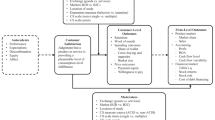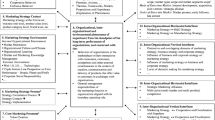Abstract
We present a two-sided matching framework to investigate the entry-level marketing assistant professor job market. Under this framework, candidates’ and departments’ decisions to mutually choose one another are driven by the matching value produced by the pair, which is in turn determined by observable department brand cues and candidates’ human brand cues such as field of research, research productivity, and ranking status. Our results suggest that matches between candidates and faculty trained in the same field do not always generate the highest matching value. Candidates’ publications in top marketing journals enhance their likelihood of matching with research-oriented hiring departments, and this effect is moderated by their field of research. In general, the ranking status of candidates boosts their chance of being matched with research-oriented hiring departments. However, this effect differs across fields, and it also interacts with candidates’ own research productivity. In particular, publications by candidates from top-ranked degree-granting departments are taken as three to four times more valuable by research-oriented hiring departments. Our work extends the current research on the marketing job market and, most importantly, quantifies and compares the significance of various human brand cues in influencing mutual choices in the job market.
Similar content being viewed by others
Notes
For a detailed overview of the hiring process in the marketing job market for assistant professors, see Close et al. (2011).
We defined the job market in this manner because, although the market for 2005 positions started interviewing in August of 2004, campus visits and offers continued until the spring of 2005. Thus, the labeling of that market could go either way, and we opted to go with the later date.
As a robustness check, we re-ran the models using only the top 20 schools as top tier. The results remain qualitatively the same. Details are available in Web Appendix D.
Web Appendix B provides details about model identification.
We ran a series of robustness checks discussed in the next section. The Matthew effect persists in each of these checks, and the size of the effect is also robust.
References
Agrawal, J., & Kamakura, W. A. (1995). The economic worth of celebrity endorsers: an event study analysis. Journal of Marketing, 59(3), 56–62.
Amaldoss, W., & Staelin, R. (2010). Cross-function and same-function alliances: how does alliance structure affect the behavior of partnering firms? Management Science, 56(2), 302–317.
Basil, M. D., & Basil, D. Z. (2006). The marketing market: a study of PhD supply, demand, hiring institutions and job candidates. Journal of Business Research, 59(4), 516–523.
Becker, G. S. (1973). A theory of marriage: Part I. Journal of Political Economy, 81(4), 813–846.
Bedeian, A. G., Cavazos, D. E., Hunt, J. G., & Jauch, L. R. (2010). Doctoral degree prestige and the academic marketplace: a study of career mobility within the management discipline. Academy of Management Learning and Education, 9(1), 11–25.
Close, A. G., Moulard, J. G., & Monroe, K. (2011). Establishing human brands: determinants of placement success for first faculty positions in marketing. Journal of the Academy of Marketing Science, 39(6), 922–941.
Coughlan, A. T., & Rao, V. R. (2003). Recruiting rookie faculty: school, candidate, competition. Asian Journal of Marketing, 9(1), 5–20.
Ding, H., Molchanov, A. E., & Stork, P. A. (2011). The value of celebrity endorsements: a stock market perspective. Marketing Letters, 22(2), 147–163.
Fournier, S. (2010). Taking stock in Martha Stewart: A cultural critique of the marketing practice of building person-brands. In M. C. Campbell, J. Inman, & R. Pieters (Eds.), Advances in consumer research (Vol. 37). Duluth: Association for Consumer Research.
Fox, J.T. 2010. Estimating matching games with transfers. Unpublished. University of Michigan.
Hasselback, J. R. (1997). The worth publishers directory of marketing faculty 1997. New York: Worth Publishers Inc.
Hasselback, J. R. (1999). The 1998–1999 Prentice hall guide to marketing faculty. Upper Saddle River: Prentice Hall.
Hasselback, J. R. (2001). Prentice hall marketing faculty directory 2001–2002. Upper Saddle River: Prentice Hall.
Hasselback, J. R. (2003). Prentice hall marketing faculty directory 2002–2003. Upper Saddle River: Prentice Hall.
Hasselback, J. R. (2005). Prentice hall marketing faculty directory 2004–2005. Upper Saddle River: Prentice Hall.
Hirschman, E. C. (1987). People as products: analysis of a complex marketing exchange. Journal of Consumer Research, 51(1), 98–108.
Hitsch, G. J., Hortaçsu, A., & Ariely, D. (2010a). Matching and sorting in online dating. American Economic Review, 100(1), 130–163.
Hitsch, G. J., Hortaçsu A., Ariely, D. (2010b). What makes you click? Mate preferences in online dating. Quantitative Marketing and Economics, forthcoming.
Hoegg, J., & Lewis, M. V. (2011). The impact of candidate appearance and advertising strategies on election results. Journal of Marketing Research, 48(5), 895–909.
Hunt, J. G., & Blair, J. D. (1987). Content, process and the Matthew effect among management academics. Journal of Management, 13(2), 191–210.
Jillapalli, R. K., & Wilcox, J. B. (2010). Professor brand advocacy: do brand relationships matter? Journal of Marketing Education, 32(3), 328–340.
Kamins, M. A. (1990). An investigation into the “Match-Up” hypothesis in celebrity advertising: when beauty may be only skin deep. Journal of Advertising 10, 4–13.
Lehmann, D. R. (2005). Journal evolution and the development of marketing. Journal of Public Policy and Marketing, 24(1), 137–142.
Manski, C. F. (1975). Maximum score estimation of the stochastic utility model of choice. Journal of Econometrics, 3(3), 205–228.
Merton, R. K. (1968). The Matthew effect in science. Science, 159(3810), 56–63.
Mittal, V., Feick, L., & Murshed, F. (2008). Publish and prosper: the financial impact of publishing by marketing faculty. Marketing Science, 27(3), 430–442.
Parmentier, M., Fischer E., and Reuber, R. (2012). Positioning person brands in established organizational fields. Forthcoming in Journal of the Academy of Marketing Science.
Politis, D. N., Romano, J. P., & Wolf, M. (1999). Subsampling. New York: Springer.
Roth, A. E., Marilda A. Oliveira Sotomayor (1990). Two-sided matching: A study in game-theoretic modeling and analysis. Cambridge University Press.
Seggie, S. H., & Griffith, D. A. (2009). What does it take to get promoted in marketing academia? Understanding exceptional publication productivity in the leading marketing journals. Journal of Marketing, 73(1), 122–132.
Spence, M. (1973). Job market signaling. The Quarterly Journal of Economics, 87(3), 355–374.
Stremersch, S., & Verhoef, P. C. (2005). Globalization of authorship in the Marketing discipline: does it help or hinder the field? Marketing Science, 24(4), 585–594.
Thomson, M. (2006). Human brands: investigating antecedents to consumers’ strong attachment to brands. Journal of Marketing, 70(3), 104–119.
Trieschmann, J. S., Dennis, A. R., Northcraft, G. B., & Niemi, A. W., Jr. (2000). Serving multiple constituencies in business schools: M.B.A. program versus research performance. The Academy of Management Journal, 43(6), 1130–1141.
Watts, D. J., & Dodds, P. S. (2007). Influentials, networks, and public opinion formation. Journal of Consumer Research, 34(4), 441–458.
Wilkie, W. L., & Moore, E. S. (2003). Scholarly research in marketing: exploring the “4 eras” of thought development. Journal of Public Policy and Marketing, 22(2), 116–146.
Williamson, I. O., & Cable, D. M. (2003). Predicting early career research productivity: the case of management faculty. Journal of Organizational Behavior, 24(1), 25–44.
Yang, Y., Shi, M., & Goldfarb, A. (2009). Estimating the value of brand alliances in professional team sports. Marketing Science, 28(6), 1095–1111.
Author information
Authors and Affiliations
Corresponding author
Additional information
The authors thank Tony Cui, Jeremy Fox, Brett Gordon, Don Lehmann, Ashutosh Prasad, Ram Rao, Brian Ratchford, Alvin E. Roth and Juanjuan Zhang for their valuable feedback, and Joseph Cote for supplying data on marketing department research productivity.
Electronic supplementary material
Below is the link to the electronic supplementary material.
ESM 1
(DOC 2012 kb)
Appendices
Appendix A: List of top-ranked marketing departments
Appendix B: Assigning marketing scholars to a research field
We used the procedure shown in Fig. 1 to assign marketing scholars to a field of research.
As shown in Fig. 1, three cases can arise when classifying marketing scholars by their field of research. These fields are CB, modeling, and strategy, and they are largely distinguished by their methodologies and research topics, in that order.
Case 1
Research methods can sometimes be associated with a particular field. For example, articles focusing on analytical derivations and econometric contributions were categorized as modeling methods, articles relying primarily on experimental manipulation were categorized as CB methods, and articles developing managerial conceptual frameworks were categorized as strategy methods. A marketing scholar was assigned to a field if all research methods used in his or her publications can be attributed to a single field. If a method did not result in classification, then the topic of the publication was used to categorize the scholar. For instance, a paper that examines the success of joint ventures is considered a strategy paper, whereas a paper that relates visual stimuli to advertising recall is considered a CB paper. The marketing scholar was categorized accordingly.
Case 2
Whenever it was not possible to classify marketing scholars based on research methods or publication topics, we turned to the topics of interest for the scholars as stated by them in their website or CV. For example, some scholars used both CB and strategy methods in their research. If the stated interests were “marketing strategy” and “marketing management” they were then classified as strategy; if the research interests were stated as “consumer behavior” and “consumer psychology,” they were then considered CB researchers. In ambiguous cases, the first stated interest on the scholar’s webpage was used for categorizing the scholar.
Case 3
If neither web pages nor publications were found for a marketing scholar, then we identified all faculty members who worked in the scholar’s degree-granting department at the time of his or her graduation. We categorized these faculty members by field of research using the methods above, and the most common field of research among the department’s faculty was assigned to the scholar. Cases in which no information was available for the scholar were rare: in our dataset, only 36 (6.8%) job market candidates had neither university webpage nor searchable information on publications.
Rights and permissions
About this article
Cite this article
Zamudio, C., Wang, Y. & Haruvy, E. Human brands and mutual choices: an investigation of the marketing assistant professor job market. J. of the Acad. Mark. Sci. 41, 722–736 (2013). https://doi.org/10.1007/s11747-013-0341-x
Received:
Accepted:
Published:
Issue Date:
DOI: https://doi.org/10.1007/s11747-013-0341-x





